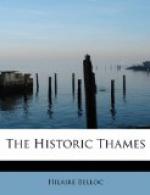It is not known whether a permanent bridge existed before the Roman Conquest. It may be urged in favour of the negative argument that Caesar had no knowledge of such a bridge, or at least did not march towards it, but crossed the river with difficulty in the higher reaches by a ford. And it may also be urged that a bridge across the Rhine was equally unknown in that time. But, the bridge once established, it could not fail to become the main point of convergence for the commerce of Southern England, and indeed for much of that which proceeded from the North upon its way to the Continent. Such an obstacle would oppose itself to every invasion, and did, in fact, oppose itself to more than one historical invasion from the North Sea. It would further prevent sea-going vessels whose masts were securely stepped and could not lower from proceeding farther up stream, and would thereupon become the boundary of the seaport of the Thames. Such a bridge would, again, concentrate upon itself the traffic of all that important and formerly wealthy part of the island which bulges out to the east between the estuary of the Thames and the Wash, and which must necessarily have desired communication both with the still wealthier southern portion and with the Continent. But, more important than this, London Bridge also concentrated upon itself all the up-country traffic in men and in goods which came in by the natural gate of the country at the Straits of Dover, except that small portion which happened to be proceeding to the south-west of England: and this exception to the early commerce of England was the smaller from the comparative ease with which the Channel could be crossed between Brittany and Cornwall.
Finally, the Bridge, as it formed the limit for sea-going vessels, formed also if not the limit at least a convenient terminus for craft coming from inland down the stream. It would form the place of transhipment between the sea-going and the inland trade.
Everything then conspired to make this first crossing of the Thames the chief commercial point in Britain; and, since we are considering in particular the history of the river, it must be noted that these conditions also made of London Bridge what we have remarked it to be, the chief division in the whole course of the stream. This character it still maintains, and the life of the river from the bridge to the Nore is a totally different thing, with a different literature and a different accompanying art, from the life of the river above bridges.
We have seen that the river when it is regarded as an avenue of access to men for commerce or for travel is, especially in early times, and with boats of light draught, of one piece from Lechlade to London Bridge. There was in this section always sufficient water even in a dry summer to float some sort of a boat. But the river, regarded as a barrier or obstacle for human beings in their movement up and down Britain, did not form one such united section. On the contrary, it divided itself, as all such rivers do, into two very clearly defined parts: there was that upper part which could be crossed at frequent intervals by an army, that lower part in which fords are rare.




